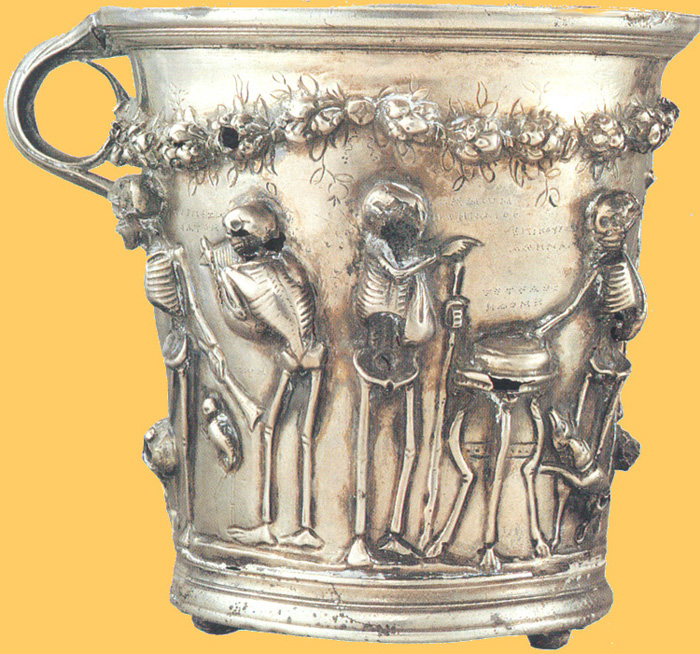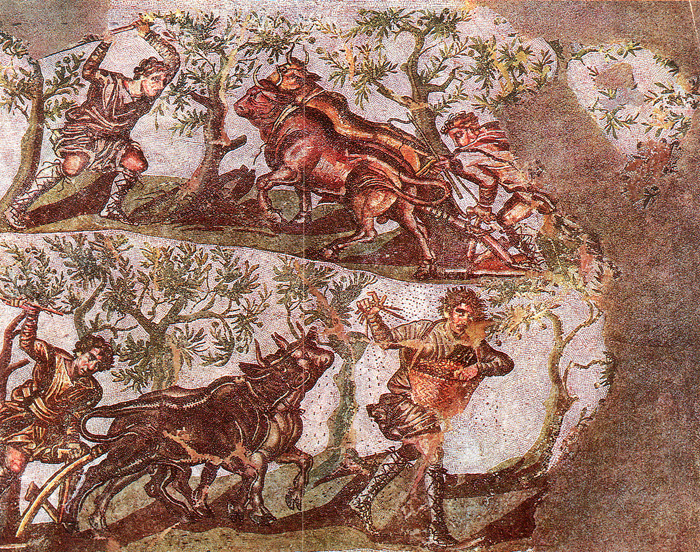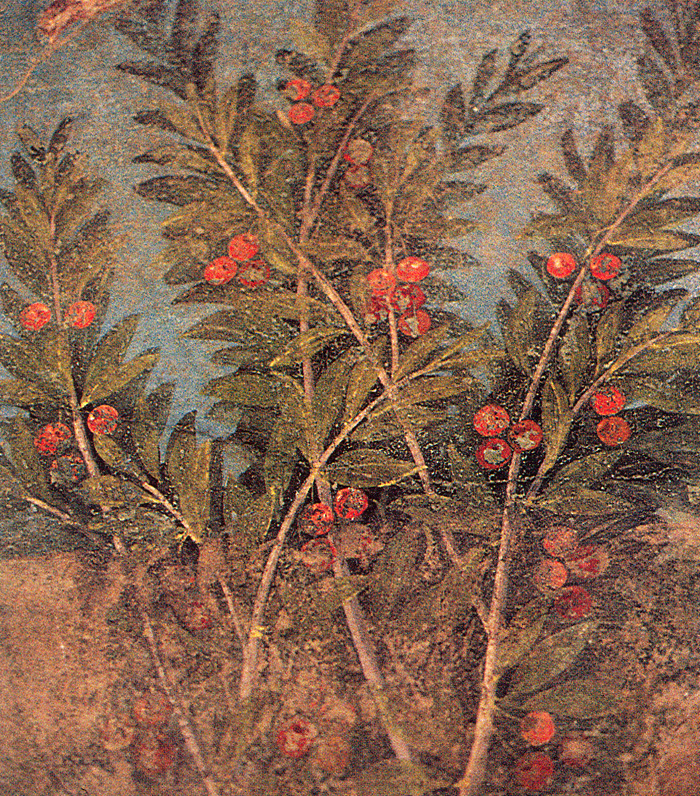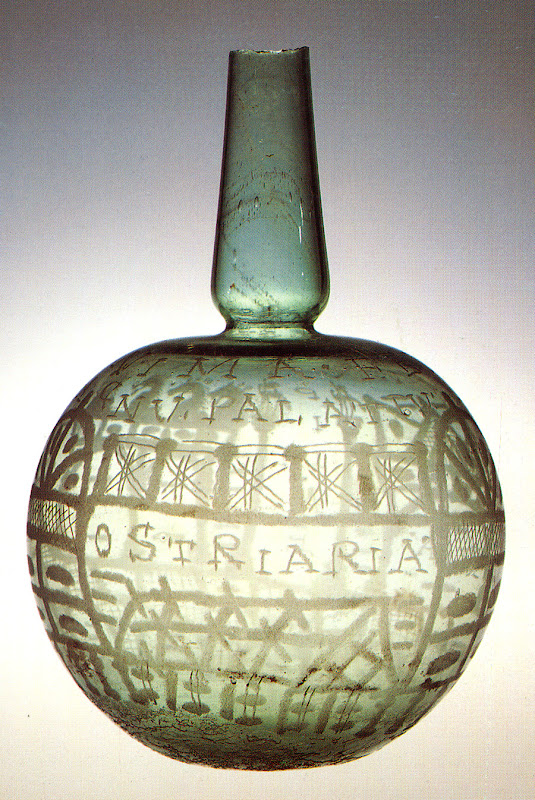
Detail of a mural ; found at the Villa of Poppaea at Oplontis (near Pompeii)
I here was several provisions, persons using this name. The most famous of them was a cook who served the emperors Augustus and Tiberius, which lived between 25 BC. BC and 37 AD. AD ..
Several authors, including Pliny the Elder, Seneca and Tacitus refer to it. Seneca, in particular tells the following anecdote:
"Today Apicius lived. In the same town where you drove the idiots happy as corrupting the youth, he has taught the art of good food and it infected the century of his science. His death is worth it tells it. Having spent his kitchen 100 million sesterces [3 to 4 million euro], after taking each of his orgies all income from the Capitol, being burdened with debts, he had the idea to do for the first time, the account of his fortune. He counted his remaining 10 million sesterces [300 to 400 thousand euro] and, as if he had to live in the torments of hunger with its 10 million sesterces, he poisoned himself. What should be its corruption and its splendor, while 10 million sesterces he represented the indigent? "
Rich, voluptuous, he spent a fortune on feasts. He opened a school where the son of gluttony patricians jostled more than in the gardens of the great philosophers. His name has become a reference, and was adopted as a treaty under Roman cuisine, which, in its present form dates from the fifth century.
The second lived in the first half of the first century (according to some, in the fourth century). He is the author of the treatise gourmet we know, the De Re coquinaria , collection of recipes organized by ingredients and dishes. In its current form, the treaty, meanwhile adjusted, completed, dates from the fourth century. It is unclear if the author was actually the name or used as a pseudonym by reference to precedent.
This treaty kitchen that appeared under the name of Caelius Apicius is one of the first textbook of culinary art in the history of mankind.

"drinking vessel" skyphos-silver-belted olive branches,
found in the Boscoreale villa on the slopes of Vesuvius. Late first century av. JC
WONDERFUL RECIPE SPICED WINE:
We put five pounds of honey in a bronze vessel where it has previously made two bushels of wine, the wine to reduce by cooking honey . Gently heated over a fire of dry wood, stirring with a spatula while cooking. If it starts to boil, stop basting with wine, but also the liquid falls when it is removed from heat. When it has cooled, the fire calls. This is done a second or third time it finally removes the heat and foam the next day. then four ounces of crushed pepper already, three scruples of mastic, a dram of leaf spikenard and saffron, five roasted date pits, with dates softened in wine, basting first wine of quality and quantity suitable to soften the mixture. This fact is poured on all eighteen bushels of sweet wine. We treat the coal product obtained.

"Life is a theater. Rejoice as you're alive" ...
silver cup from the late first century av. JC found Boscoreale (Campania)
silver cup from the late first century av. JC found Boscoreale (Campania)
RECIPE OF WINE OR PINK PURPLE:
Take rose petals which you removed the white tab, put them in chains and put in as much as possible in wine for seven days to leave. The past seven days, remove the pink wine and replace them by other fresh string, you let sit seven days in the wine, then you withdraw. Repeat a third time, remove the roses and filter the wine, and when you want to drink it, add honey to make wine roses. Take good care of roses place of choice, not dewy. Prepare as above with wine and purple mingle there honey in the same way.

Labour by sowing among the olive trees. Mosaic Cherchel (Algeria), about 200-210 AD. JC
QUENELLE:
Put in a mortar pepper, lovage and oregano, triturate, pour garum *, add cooked brains, crush carefully so as not to leave pieces. Add five eggs and beat thoroughly to incorporate. Work with garum, pour in a copper saucepan and cook. After cooking, spread on a clean table and dice. Put in mortar pepper, lovage and oregano, triturate, mix well, in a saucepan and boil. When it has boiled, pulp crumble, link, stir and pour into a dish with mushrooms. Sprinkle with pepper and serve.

Dates for vials, found at Pompeii
vulva DUMPLINGS RECIPE:
crushed pepper and cumin, two small heads of leeks cleaned up the tender Street and garum, we add the meat well crushed and triturated again with the contents of the mortar, way to amalgamate them. Put peppercorns and pine nuts and garnish with crushing vulva thoroughly washed. It cooks well with water, oil, garum, a bunch of leeks and dill.

Cherry or strawberry tree ... Mural of Pompeii house orchard
RECIPE GRILLED VULVA:
Roll it into the sound, then put it in the brine and cook it well.

Glass vial contained the oyster; grave Populonia (Etruria), late third or early fourth century AD. JC
DUMMY:
Boil nipples, tie them with hâtelets reed, sprinkle with salt and put them in the oven or grill. Toast lightly. Crush pepper, lovage, the garum, wet and pure wine straw wine, bind to the cornstarch and pour over the nipples.

twig street in a bottle of grappa (distilled grape marc)
TEATS STUFFED:
We stack pepper, caraway, salt sea urchins, are sewn together and baked. We eat with hallec and mustard.

Young man and a courtesan. Wall painting from Herculaneum
RECIPE OF THE PATINA APICIUS:
Take the teat of a sow cooked and cut into pieces, the flesh of fish, meat chicken, becfigues or fillets cooked thrushes and everything you better. Chop everything carefully, except becfigues. Mix raw eggs with oil. Grind pepper and lovage, wet with garum, wine and wine straw, put in a pan to heat and bind with the cornstarch. But before you throw in all mince and boil. After cooking, remove from heat and pour the juice with a ladle into a mold in layers, with the peppercorns and pine nuts, so that for each layer, you place first in a rolled back, then Likewise a piece of dough. Alternate layers of dough and filling ladles. Place the top sheet of dough pierced with a hollow reed. Sprinkle with pepper. But first bind the flesh and breaking the eggs and put in casserole with stuffing.

GARUM WINE FOR FATTY LIVER **
pepper, thyme, lovage, garum, a little wine and oil.
Another recipe:
Mince the liver with a reed soak in the garum. pepper, lovage and two bay windows, wrap it in a strainer, roast on the grill and serve.

Glass Cologne, fourth century AD. JC
SNAILS fertilized MILK:
Take snails, clean them and remove the membrane so that they can leave. Put in a container of milk with salt for a day, and only milk the following days, and clean their filth every hour. When they have fattened to the point of being unable to return to their shell, ... and fry in oil. Sprinkle garum wine. Similarly, one can also fatten the slurry.

Fresh fruit, canned fruit ... Mural of Pompeii
SOUP FOR THE BELLY:
Boil water chard and leeks chopped preserved; arrange them in a saucepan. Crush pepper, cumin, wet garum and straw wine to sweeten slightly. Boil and serve after boiling.

Thrush, Mosaic, Tunisia
* The garum or Liquamen (which means "juice" or "sauce" in Latin) was sauce, the main condiment used in Rome from the Etruscan period and in ancient Greece. It was fermented fish that long in a large quantity of salt to prevent decay. It was an ingredient in many dishes, especially because of its strong salty taste.
garum The most famous, "said garum allies (garum sociorum), was manufactured in Betic (including Baelo Claudia), southern Spain today so in Andalusia, from the bluefin tuna that migrate from the Atlantic to the Mediterranean. The result was a large fish, including salted product was marketed. Garum it was developed with the blood, eggs, and the digestive system of fish, mixed with a large amount of salt (at least 50% of total volume). The presence of salt inhibits the natural breakdown, maceration occurs probably through the action of digestive juices tuna. It is therefore not a putrefaction.
garum Some lower quality, prepared directly from the flesh of tuna or other fish (such as mackerel), were made throughout the Mediterranean basin. All these were marketed in garum amphorae amphorae were small, considering the price of content. It also sold the Allec, cheaper, that was what was left over when the liquid had been removed.
garum The flavor is closer to that of Vietnamese fish sauce.
It is the source of pissala pissalat or a condiment neighbor garum, consumed in the Nice area.

Cover skillet bronze Mundelsheim (Germany)
** The history of foie gras goes back to ancient Egypt (murals of old tombs in Saqqara 4500 years) . The Egyptians force-fed several species of waterfowl birds, including geese, using roasted grains and pellets moistened. However, we have no evidence of use of liver fat in the diet in Egypt (or text or pictures in the Cairo Museum and the Musée du Louvre): many ancient peoples like the Chinese since 4500 years in the south-west France until the nineteenth century have played or practiced force-feeding geese and ducks for animal fat in meat (fat used to preserve food for lighting and cooking) and not to get livers fat. Later the practice spread throughout the Mediterranean region. The Greek poet Cratinus evokes the fifth century BC. AD
The practice continued under the Roman Empire. Pliny the Elder mentions the feeding of geese with dried figs. In the fourth century, of Apicius De re coquinaria gives his first recipe. The liver produces Jecur ficatum name, which translates literally as' liver with figs. The former retained only the term or ficatum fig for his name, which gave shape figido the eighth century, then Fédié, Feie the twelfth and final "liver". However, this root is not found in French, Italian, Portuguese, English and Romanian.
tradition of foie gras has been perpetuated after the fall of the Roman Empire in Central Europe, in communities Jewish. Jews frequently used goose fat for cooking because the meat with butter and lard they were forbidden. In addition, olive oil and sesame were difficult to obtain in Europe and Central West. We have no evidence (texts, pictures) from the practice of force-feeding and the use of foie gras in southwestern France in the Middle Ages and the Renaissance.
Thus, if traditional, two French regions, the Southwest and Alsace, dispute the authorship of this food festival, origin of liver fat is actually very old.
Maize is native to Central America, feeding on corn arrived late. Gavage with figs is historic, now ...

Detail of a mosaic found in Rome, at the foot of the Aventine; time of Hadrian
0 comments:
Post a Comment